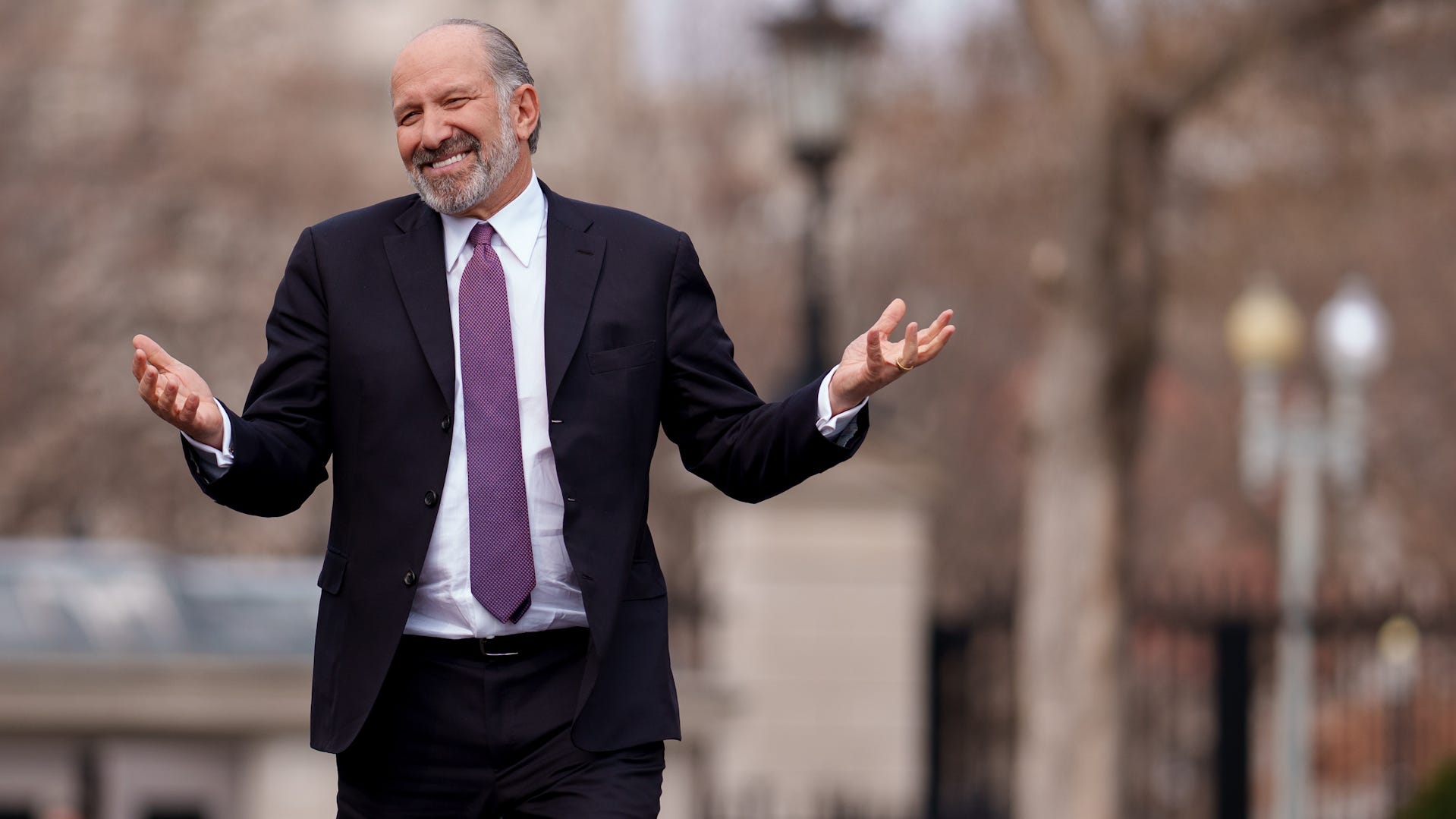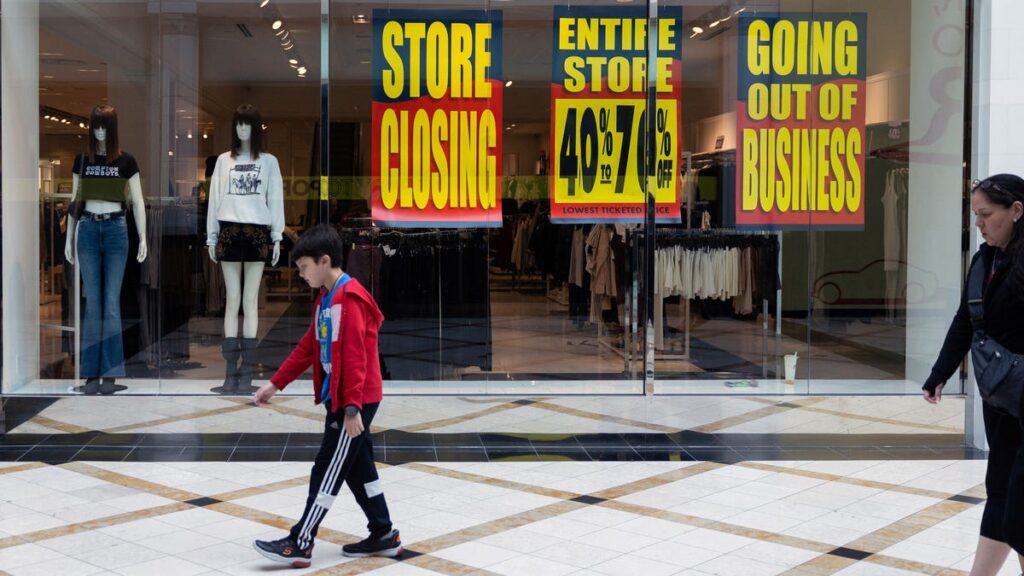Forecasters say the economy will nearly stall or slip into recession over Trump’s tariffs. Some say the president’s 90-day pause doesn’t change their outlook.
Republican party starts to split as Trump hits the economy
Some Republicans share their frustration after President Donald Trump hits the economy with tariffs.
- Experts predict the economy will nearly stall in 2025, growing 0.8%, down from their projection of 1.7% just last month.
- The 46 economists surveyed by Wolters Kluwer Blue Chip Economic Indicators estimate a 47% chance of recession, up from 25% in February.
- “We had a very solid economy at the beginning of the year,” Barclays economist Marc Giannoni said. “The tariffs are…weakening activity and weakening demand.”
Forecasters have a bleak outlook on the U.S. economy because of President Donald Trump’s escalating trade war even amid his 90-day pause of the highest tariffs on more than 50 countries − and they see the odds of a recession as a tossup.
The experts predict the economy will nearly stall in 2025, growing 0.8%, down from their projection of 1.7% just last month, according to the average estimate of 46 economists surveyed by Wolters Kluwer Blue Chip Economic Indicators on April 4 and April 7.
They reckon there’s a 47% chance of recession, up from 25% in February.
‘Even higher tariffs’
The economy grew a healthy 2.8% last year.
The poll was conducted after Trump unveiled his reciprocal tariffs on dozens of countries on April 2 but before he announced a 90-day pause on duties as high as 50% on all nations other than China on April 9 and exemptions for many electronics products late Friday.
Yet some of the surveyed economists interviewed in recent days noted that Trump at the same time raised the import fee on Chinese shipments to an outsize 145%, more than offsetting the economic benefits of the concessions.
“That adds up to even higher (total) tariffs,” said Barclays economist Marc Giannoni. The effective, or average, U.S. tariff, on all imports rose to 30%, up from 23% when Trump announced the reciprocal duties. Before the trade war, the average U.S. tariff rate was 2% to 3%.
In yet another twist, late Friday, the Trump administration announced exemptions for smartphones, computers, chips and other electronics products. That, Giannoni said, would lower the effective tariff rate back to 23% and “should reduce the negative effects on activity and inflation,” but wouldn’t significantly change Barclays’ projection for a recession later this year.
Commerce Secretary Howard Lutnick told ABC News on April 13 the carevouts for the electronics products is temporary and tariffs for those items would be included in a duty on computer chips that Trump plans to impose in a month or two. That would further mitigate any economic benefit from the exemptions.
A separate survey of 31 experts this week – 21 of whom responded the day Trump announced the 90-day pause – reveals a similarly dour view, according to the poll by the National Association of Business Economics. They expect the economy to grow just 0.7% this year.
The average tariff rate should gradually fall to about 20% this year and 15% in 2026 as companies import fewer Chinese goods because of the high fees and increasingly source their products from other countries, Giannoni said. Still, he expects overall inflation to rise from 2.4% in March to 3.4% by the end of the year, based on the Consumer Price Index.
Is the US economy declining?
Forecasters say the economy was likely to slow this year after a post-pandemic burst of activity but consumers were in generally good shape, with low debt and wage growth that was still outpacing inflation. The tariffs, however, are expected to drive up prices as manufacturers and retailers pass along much of the fees to consumers.
That’s likely to sap their spending power, which makes up about 70% of economic activity.
“We had a very solid economy at the beginning of the year,” Giannoni said. “The tariffs are…weakening activity and weakening demand.”
“It’s a massive shock,” said Nationwide Chief Economist Kathy Bostjancic, who expects the economy to grow 1% this year and believes the question of whether the nation tips into recession is a borderline call.
Is a US recession coming?
Giannoni figures the nation will experience a mild recession the second half of the year, with gross domestic product falling 1.5%, net job losses of less than 100,000 and the 4.2% unemployment rate peaking at 4.7%.
Besides the hit to consumer spending broadly, Bostjancic said the turmoil in the stock market has reduced the wealth of high-income Americans who have accounted for the lion’s share of consumption, causing those households to spend less. She also expects the Trump administration’s substantial layoffs to deliver another blow to the economy.
Consumer sentiment this month fell to the lowest level since June 2022 and Americans’ inflation expectations a year from now rose to 6.7%, the highest since 1981, according to a survey by the University if Michigan.
Economists expect consumer spending to increase 0.9% this year, down from 2.8% in 2024, according to the Wolters Kluwer poll.
Is business investment increasing?

Trump smartphone tariff measures ‘coming soon,’ Lutnick says
Commerce Secretary Howard Lutnick said that tariffs on smartphones and other electronics would come “soon.”
And while the 90-day pause on many tariffs grants a reprieve to many countries as well as consumers, “The disruption we are seeing and the uncertainty we are seeing is already bad for growth,” Giannoni said. “The 90-day pause is extending the uncertainty.”
Business investment is projected to grow about 1.2% this year, down from 3.6% in 2024, according to the Wolters Kluwer survey.
Which tariffs have gone into effect?
Trump’s reciprocal tariffs, theoretically aimed at matching the fees other countries charge for U.S. shipments to their countries, included a minimum 10% fee and additional charges of up to 50% on more than 50 nations. Those took effect Wednesday.
The president already had imposed a 20% fee on China; 25% on imported steel and aluminum; 25% on all imported cars and light trucks; and 25% on some goods from Canada and Mexico not covered by a trade agreement.
